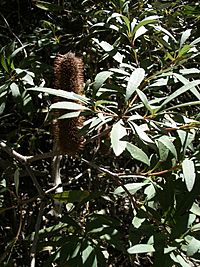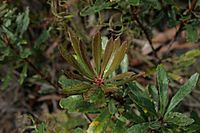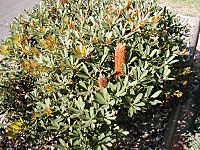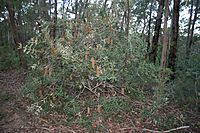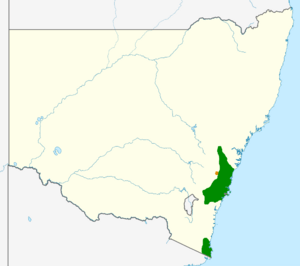Banksia paludosa facts for kids
Quick facts for kids Banksia paludosa |
|
|---|---|
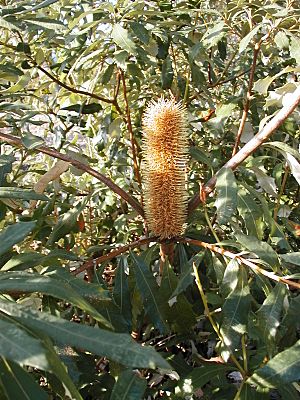 |
|
| Banksia paludosa flower spike Stanwell Tops, New South Wales |
|
| Scientific classification | |
| Kingdom: | |
| (unranked): | |
| (unranked): | |
| Order: | |
| Family: | |
| Genus: | |
| Subgenus: | |
| Section: | |
| Series: | |
| Species: |
B. paludosa
|
| Binomial name | |
| Banksia paludosa |
|
The Banksia paludosa, also known as the marsh banksia or swamp banksia, is a type of shrub found in Australia. It grows naturally in New South Wales, mainly between Sydney and Batemans Bay. There's also a smaller group of these plants further south near Eden.
This plant is special because different kinds of animals help it grow. Small native mammals, like the brown antechinus and sugar glider, are important for spreading its pollen. Birds called honeyeaters also visit its flowers, along with ants and European honey bees. How the plant reacts to bushfires depends on its type. Some Banksia paludosa plants can regrow from a special woody base underground, while others are killed by fire but grow back from seeds stored in their cones. People sometimes grow B. paludosa in gardens, and there are even smaller, "dwarf" versions available.
Contents
What it Looks Like
There are two main types (called subspecies) of Banksia paludosa. They look similar in their leaves and flowers, but they are different in size, how they grow, and how they survive bushfires.
Most Banksia paludosa plants are spreading shrubs, usually less than 1.5 meters (5 feet) tall. In some open, shrubby areas, they might be even shorter, sometimes only 30 centimeters (12 inches) high. This type of banksia has a woody base called a lignotuber. This lignotuber helps the plant regrow after a fire.
The other type, called subspecies astrolux, is a taller shrub that can reach 5 meters (16 feet) high. It doesn't have a lignotuber.
The bark and leaves of the plant feel rough. However, new shoots are covered in fine, soft hairs. The stems are usually thin, less than 2 centimeters (0.8 inches) across. They can be red or yellow when they are young.
The leaves grow in a pattern along the stems. They are shaped like a spear or an egg, about 4–13 centimeters (1.6–5.2 inches) long and 1–3 centimeters (0.4–1.2 inches) wide. The edges of the leaves are mostly smooth, but sometimes have a few small teeth. The underside of the leaves is white, with a clear central vein.
Banksia paludosa flowers during autumn and winter, from April to July. The flowers grow in tall, cylinder-shaped spikes, which are called inflorescences. These spikes grow from stems that are at least three years old. Each spike is about 3.2–4 centimeters (1.3–1.8 inches) wide and 7–13 centimeters (2.8–5.2 inches) tall. The individual flowers on the spike are more spread out than on other banksias, which makes this species easy to spot.
When the flower spikes are still buds, they are pale to golden brown. As they open, they turn a brighter gold color. Sometimes, the buds can have a grey tip. The flowers on a spike open from the bottom to the top, and the whole process takes about six to eight weeks.
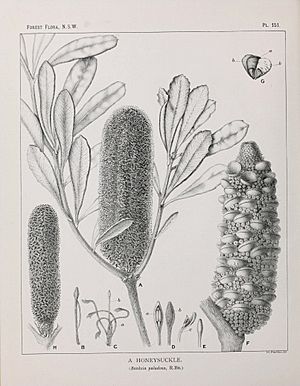
As the flower spikes get older, they turn grey, and the old flowers stay on the plant for many years. Each spike can develop up to 60 woody seed pods, called follicles. These pods are narrow and oval-shaped, about 0.9–1.8 centimeters (0.35–0.71 inches) long. Some of these pods open on their own, but most stay closed until a bushfire burns them.
Each pod holds one or two seeds. The seeds are dark brown and have a wing-like part that helps them fly in the wind. The seeds are about 1.3–1.8 centimeters (0.51–0.71 inches) long. When a seed sprouts, it first grows two small, oval-shaped leaves called cotyledons. These first leaves can stay on the plant for several months as more leaves grow.
Banksia paludosa can look similar to other banksia species. For example, its first leaves are very much like those of B. marginata and B. integrifolia. Larger Banksia paludosa shrubs also look a bit like Banksia conferta subsp. penicillata, but that plant has wider flower spikes and more crowded buds. It also looks a little like B. oblongifolia, but B. oblongifolia has a clear central vein on the underside of its leaves, rusty hairs on new growth, and its old flower spikes are bare. B. oblongifolia also prefers drier, rocky soils, while B. paludosa likes wetter, sandy soils.
Naming and Classification
The Banksia paludosa was first officially described by a botanist named Robert Brown in 1810. He gave it the name Banksia paludosa. The word paludosa comes from a Latin word meaning "marsh" or "swamp." This name can be a bit confusing because the plant often grows on sandstone ridges and in heathland, not just in swamps. Its common names, marsh banksia and swamp banksia, come from this scientific name.
Later, in 1870, another botanist, George Bentham, thought it was just a type of B. integrifolia. But in 1981, Alex George decided it was a separate species again.
Where it Fits in the Banksia Family
Scientists classify plants into groups to understand how they are related. The way Banksia paludosa is grouped within the Banksia genus is based on the work of botanist Alex George from 1999.
In this system, B. paludosa is part of the Banksia subgenus Banksia because its flowers grow in the typical Banksia spikes. It's also in the section Banksia because of its straight flower parts, and in the series Salicinae because its flower spikes are cylindrical.
Here's a simplified look at where B. paludosa fits in the Banksia family tree:
- Genus Banksia
- Subgenus Isostylis
- Subgenus Banksia
- Section Oncostylis
- Section Coccinea
- Section Banksia
- Series Grandes
- Series Banksia
- Series Crocinae
- Series Prostratae
- Series Cyrtostylis
- Series Tetragonae
- Series Bauerinae
- Series Quercinae
- Series Salicinae
- B. dentata – B. aquilonia – B. integrifolia – B. plagiocarpa – B. oblongifolia – B. robur – B. conferta – B. paludosa – B. marginata – B. canei – B. saxicola
More recent studies using DNA have suggested that Banksia paludosa is very closely related to the three types of B. integrifolia.
Two Types of Banksia paludosa
Scientists recognize two subspecies (types) of Banksia paludosa:
- The more common type, subspecies paludosa, is a shrub that grows up to 1.5 meters (5 feet) tall and can regrow from its woody base (lignotuber) after a fire.
- Subspecies astrolux is a rarer plant found only in Nattai National Park. It's a taller shrub, reaching 5 meters (16 feet) high, and it doesn't have a lignotuber. This means it dies in a fire but regrows from seeds. This subspecies was named by Alex George, with "astrolux" coming from Ancient Greek and Latin words meaning "star" and "light," referring to the "Starlight Trail" where it was found.
Sometimes, Banksia paludosa can mix with other banksia species, like Banksia marginata and B. integrifolia, creating hybrid plants. This has been seen in places like Nadgee Nature Reserve.
Where it Lives
Both types of Banksia paludosa are native only to New South Wales, Australia.
The common subspecies, paludosa, is found from Glen Davis down through the Sydney area to Ulladulla on the South Coast. There's also a separate group of these plants near Eden. It can be found inland as far as Taralga. While it was once recorded further north, it's not been found there recently. It used to grow in parts of Sydney like Centennial Park and La Perouse, but it's no longer there.
The rarer subspecies, astrolux, is only found in Nattai National Park.
Both subspecies grow in sandy soils that don't have many nutrients and drain well. They are often found in open woodlands alongside trees like Sydney peppermint (Eucalyptus piperita), silvertop ash (E. sieberi), and smooth-barked apple (Angophora costata). They also grow in heathland areas with other plants like dwarf banksia (Banksia oblongifolia) and dagger hakea (Hakea teretifolia).
How it Lives (Ecology)
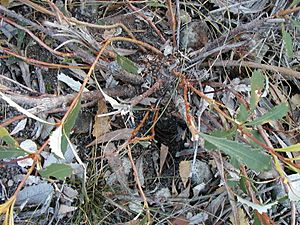
Banksia paludosa subspecies paludosa grows slowly. After a bushfire, it can regrow from its special woody base, the lignotuber. It takes about three years for these plants to flower well after a fire, and they can live for about 60 years. New plants also sprout from seeds that are released after a fire.
Like all banksias, Banksia paludosa has special roots called proteoid or cluster roots. These roots help the plant get nutrients from the poor Australian soils, especially phosphorus, which is often hard to find.
The flower spikes of B. paludosa cannot pollinate themselves. They need animals to carry pollen from one plant to another to make seeds. Small mammals, like the brown antechinus, often visit the flowers and help with pollination. The sugar glider is another mammal that helps.
Many bird species also feed on the flowers, including the red wattlebird, yellow-faced honeyeater, white-eared honeyeater, crescent honeyeater, New Holland honeyeater, and eastern spinebill. Insects like the European honey bee and ants have also been seen visiting the flower spikes.
Growing it in Gardens
Banksia paludosa was first grown in gardens in England in 1805. It was planted in famous gardens like Kew and Cambridge Botanic Gardens.
Today, B. paludosa is grown in Australian gardens. It grows best in a sunny spot with soil that drains well, and a pH level between 5.5 and 7.5. It grows slowly, taking about 6 to 10 years to flower from a seed. You can grow it from seeds, which usually sprout in about two weeks, or from cuttings.
There are also smaller, "dwarf" forms of Banksia paludosa available, which only grow to about 60 centimeters (2 feet) tall. These are great for smaller gardens and are usually grown from cuttings to keep their small size. While some people think its flowers are "rather dull," its leaves are considered "attractive." Some forms, like one from Jervis Bay with large orange flower spikes, are thought to be very good for gardening.


